Among the few who have reviewed all of the Disney anim-anthology movies from the 1940s, Fun and Fancy Free and The Adventures of Ichabod and Mr. Toad, each of which consists of two featurettes, seem to be regarded as the best or at least one and a half of them are. You won’t find me fighting that consensus, though nostalgia may play a part in my case. These are the two I watched the most as a child, which isn’t so impressive when you consider that the only other one that I had an opportunity to watch then was Melody Time. But still I rented Melody Time once as a kid and never felt the need to do so again. These two films, on the other hand, I rented multiple times.
Fun and Fancy Free (1947)
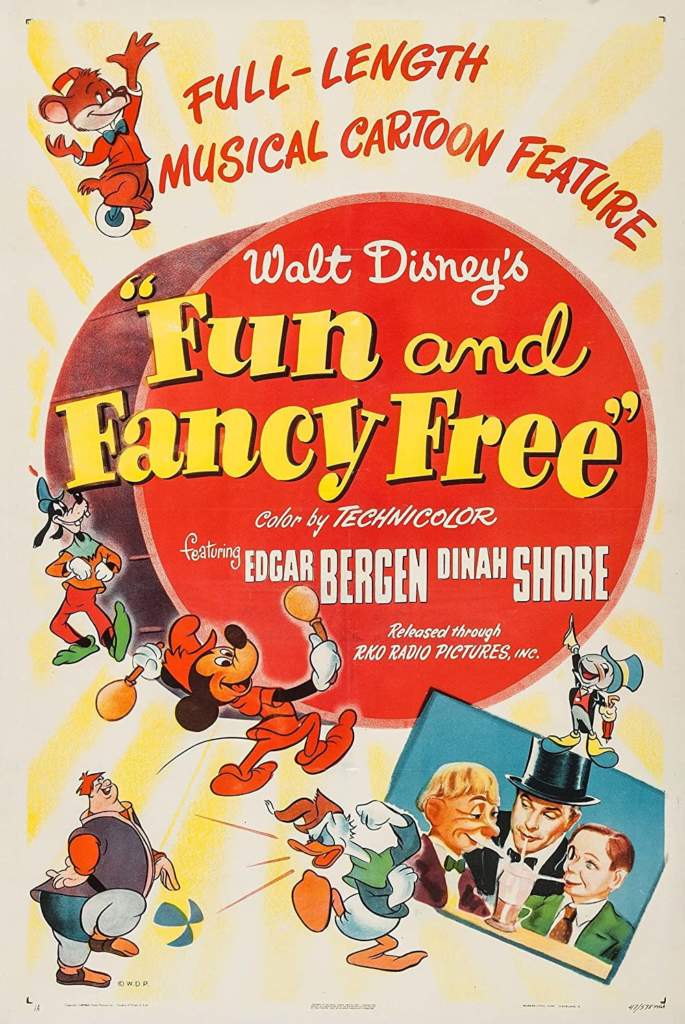
The party-tastic vibe for which this movie strives and which, in my opinion, it generally achieves is apparent from the very design of the opening credits, which are accompanied by the title song.[1]I haven’t been mentioning who wrote all the songs for the Disney anim-anthologies except for Fantasia‘s classical compositions. That’s partly because there were so many of them by … Continue reading
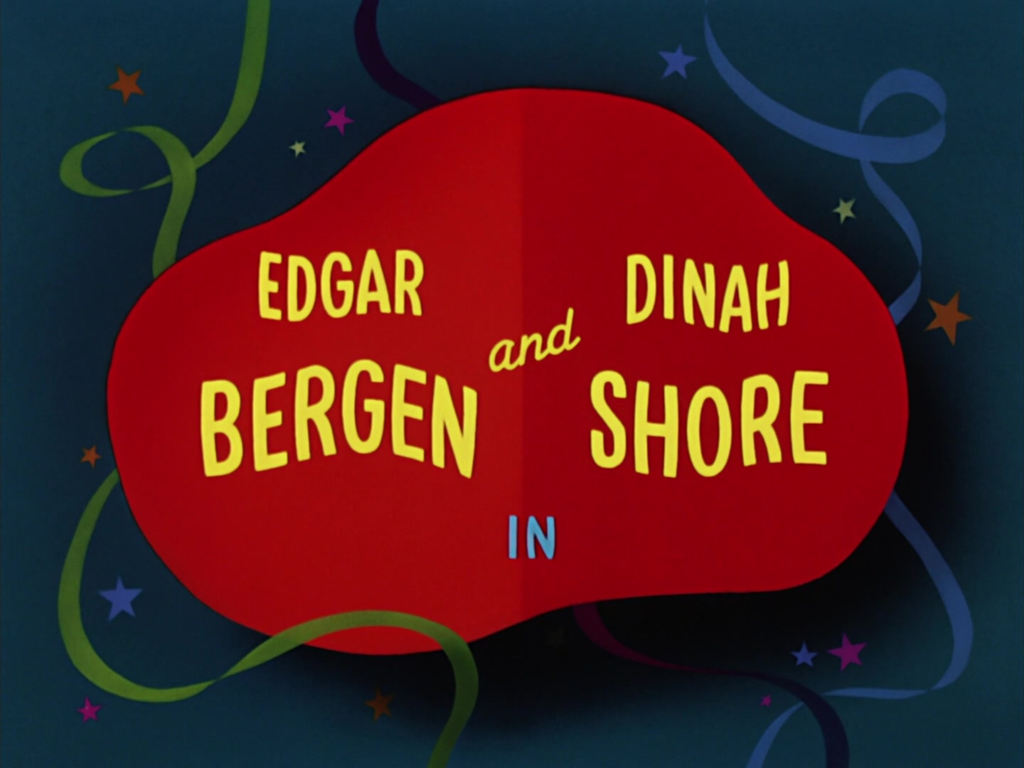
We immediately segue from that into another song, Get a Happy Go Lucky Feelin’, with pretty much the exact same message. It’s being sung by Jiminy Cricket (voiced by Cliff Edwards) as he cavorts around a modern human-sized house. (It’s later implied that this house is in Hollywood and is the home of Disney child star, Luanna Patten. You may remember her from Melody Time, which wouldn’t come out until later.) The song’s sentiment, that everyone needs to stop worrying and just relax, doesn’t strike me as consistent with Jiminy’s conscientious character from Disney’s Pinocchio, but what do I know? Speaking of Pinocchio, if you’re a fan of that movie, you may be tickled to see Jiminy encounter another character from it in this scene, Cleo the goldfish. The cat, however, doesn’t look like Figaro for whatever reason.
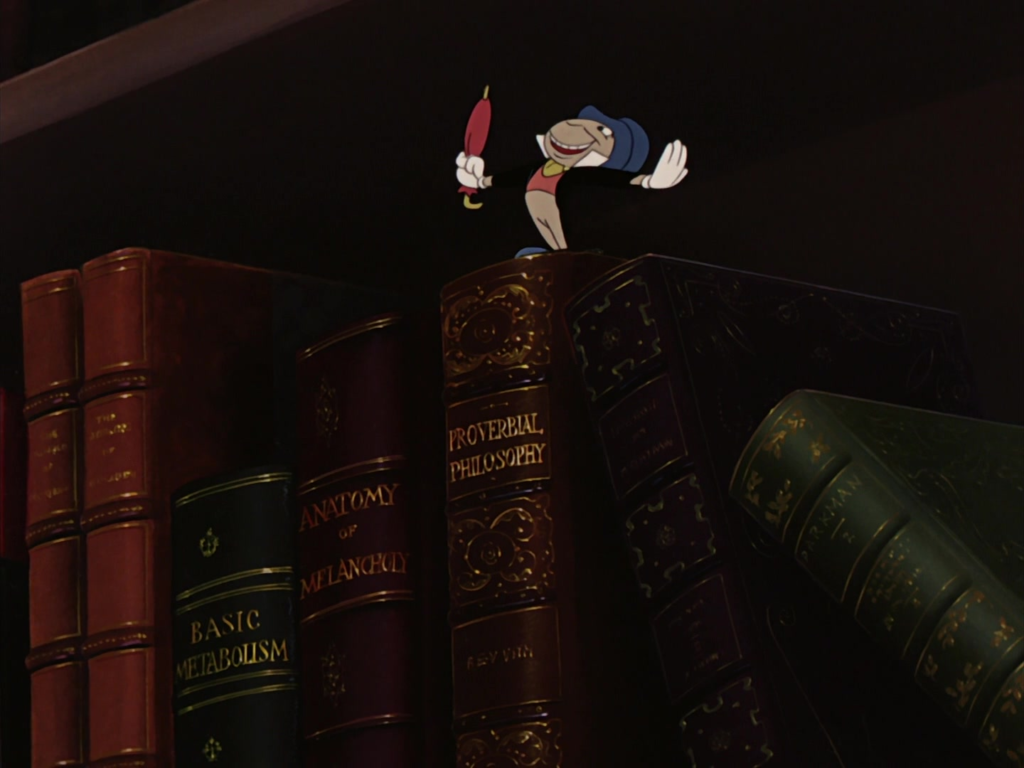
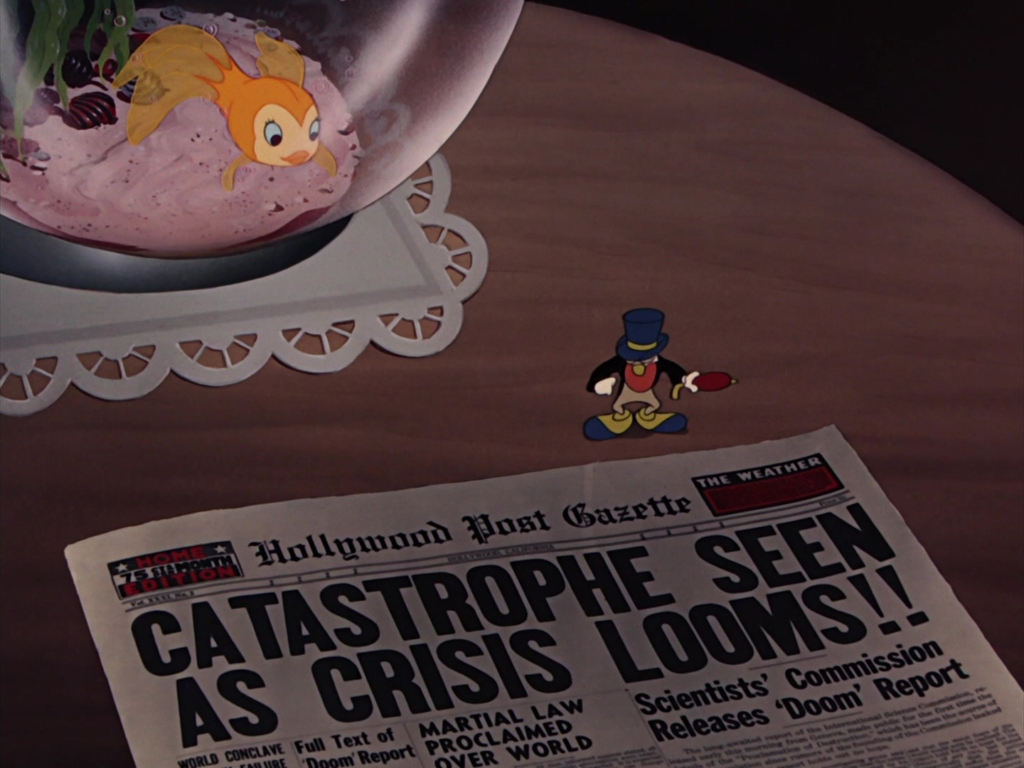
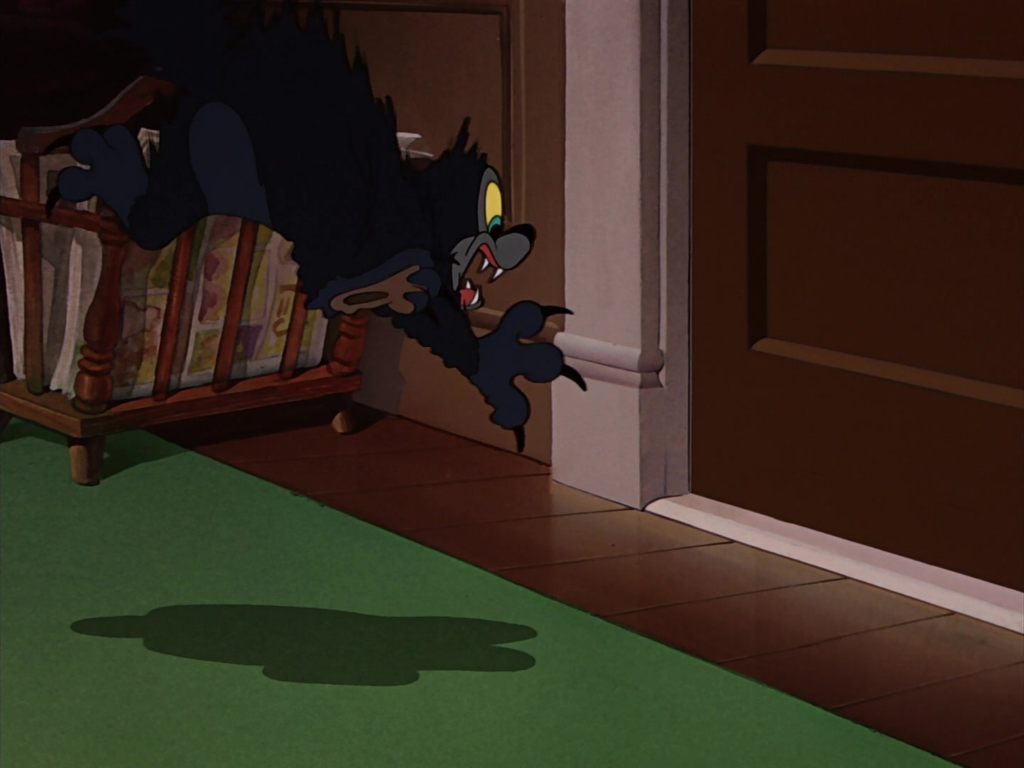
Jiminy has been described as the host of this movie as he’s the one who introduces the different segments, but he doesn’t really address the viewer much at all and he only introduces the segments in the broadest sense of the term. His role here is quite random. You see the aforementioned cat chases Jiminy into the adjoining room, a children’s playroom where he meets a depressed looking doll and a droopy teddy bear. To cheer them up, he plays “a musical story sung by Dinah Shore” on the record player.[2]I wonder if the fact that Jiminy doesn’t choose one of the records labeled Bach or Beethoven in the background can be seen as a renunciation of Fantasia.
Bongo
The first half of Fun and Fancy Free was based on a short story by Sinclair Lewis. I remember studying Sinclair’s novel, Babbit, in high school. For those of you who haven’t had that experience, it’s a cynical satire about the emptiness of then current American middle-class society. That’s the kind of thing for which Lewis was known. From what I’ve gathered the literary Bongo was less depressing than Babbit but more cynical than the cartoon that Disney ultimately made out of it. The title character is a performing circus bear who longs to escape his gilded cage and lead the life of a wild bear in what appears to be the Canadian Rockies. He gets his wish, but navigating the wilderness proves to be harder than he expected.
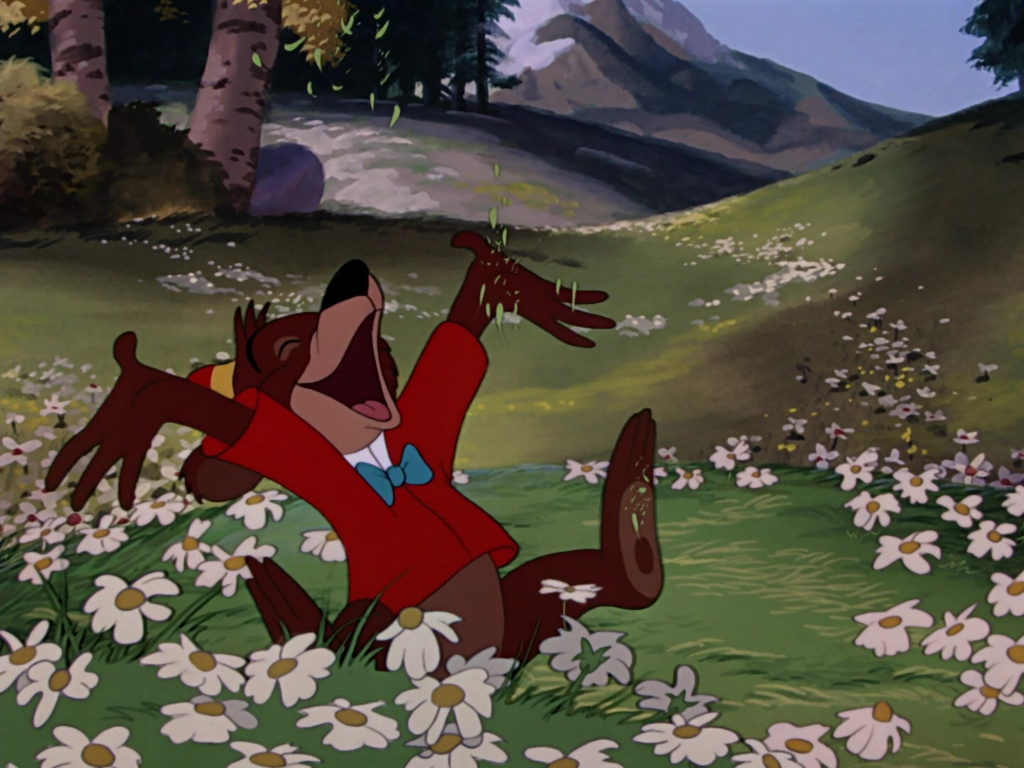
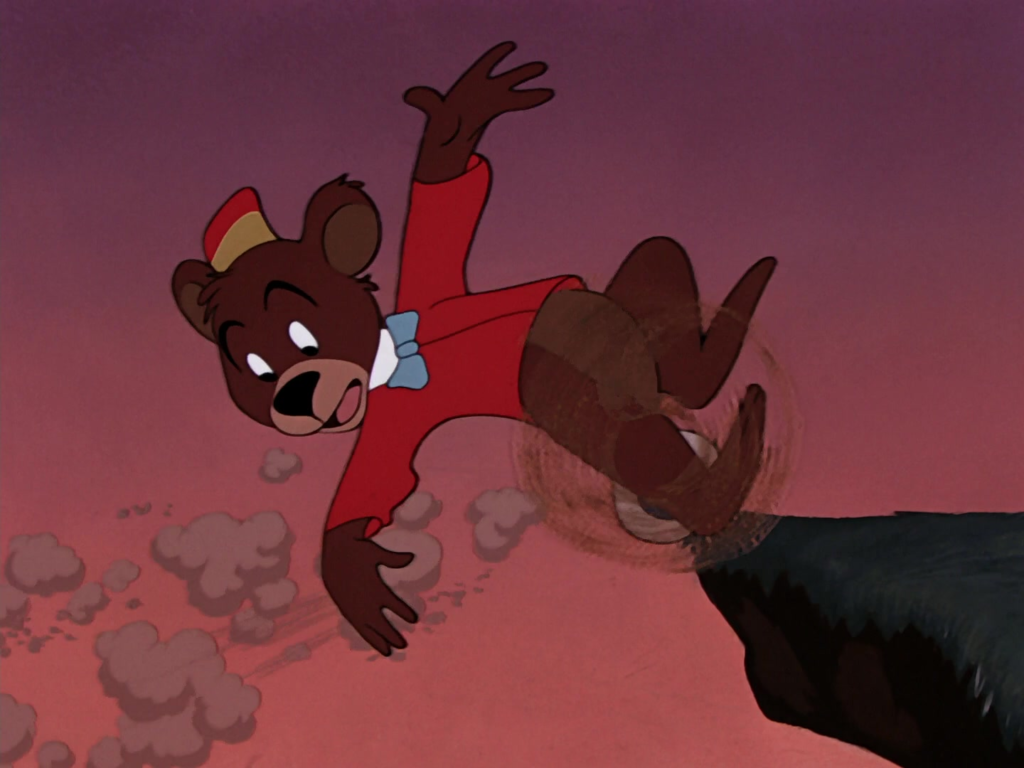
I’ve always considered this the less rewatchable of the movie’s halves, and that seems to be the general consensus, so it’s always a pleasant surprise to rewatch it and find that it’s so good. The story with its theme of nature vs. nurture is pretty unusual for Disney[3]I’d call this a Disney-fied Call of the Wild, but there actually was a Disney version of Call of the Wild in 2020. and while it’s not the most unpredictable thing in the world, it’s less predictable than, say, Little Toot from Melody Time. (I don’t think anyone would guess what the complication in Bongo’s romance with Lulubelle, the wild bear he meets, would be.) The visual gags work, and the songs are all pleasant. The most visually entertaining scene is a romantic fantasy of Bongo and Lulubelle in a heaven of heart-shaped clouds accompanied by mischievous little cupid bears. There’s also a fun action-climax that makes great use of Bongo’s unicycling skills, but I won’t share any images from that for fear of spoiling anything.
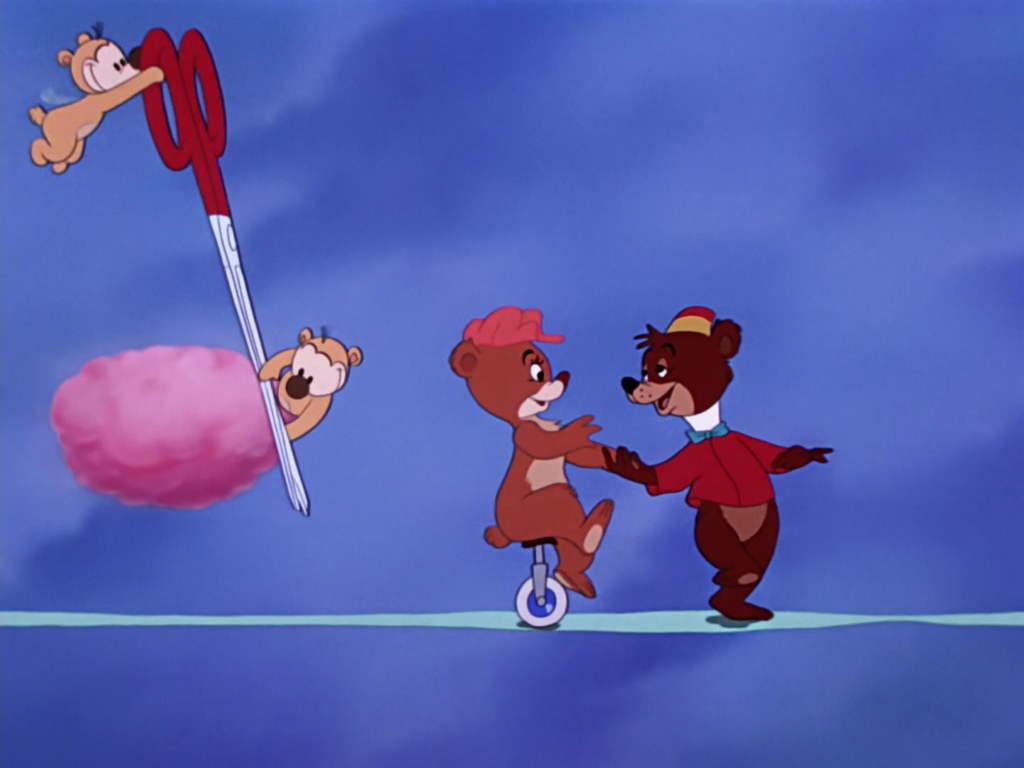
What mainly keeps this from being one of the best shorts in all the Disney anim-anthologies is that Bongo himself isn’t a very distinctive character. He’s pretty much an ursine clone of Mickey Mouse. Still, that’s not the worst thing even if it isn’t the best either.
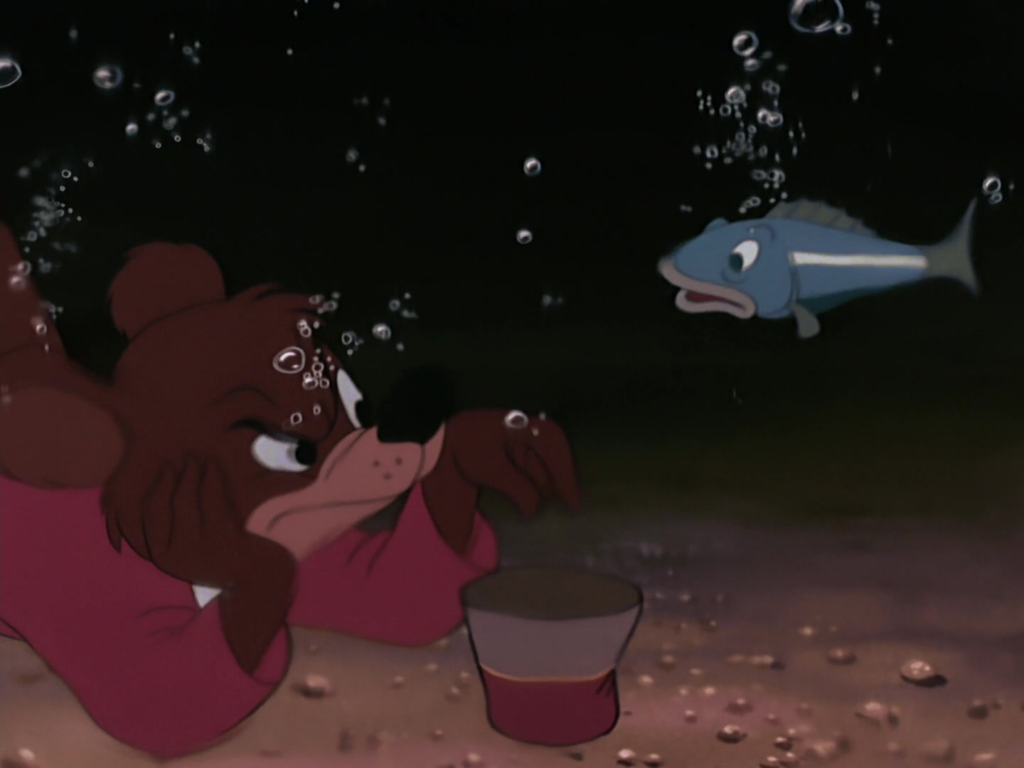
Mickey and the Beanstalk
As random as some of these anim-anthologies can get, Fun and Fancy Free might be the most random of them all. Not only does it consist of two unrelated stories stitched together, it can barely be said that they share a framing device. After Bongo, Jiminy Cricket finds an invitation addressed to Luanna Patten. It’s to a party at the home of ventriloquist Edgar Bergen and his dummies, Charlie McCarthy and Mortimer Snerd. (The outside of Bergen’s house is animated in this movie and the inside is live action.) Jiminy heads on over and is just in time to overhear Bergen tell Luanna the story of Mickey and the Beanstalk.[4]At one point in its production history, when it was going to be a feature length movie, Mickey and the Beanstalk was apparently going to have a very different framing device, one that sounds more … Continue reading
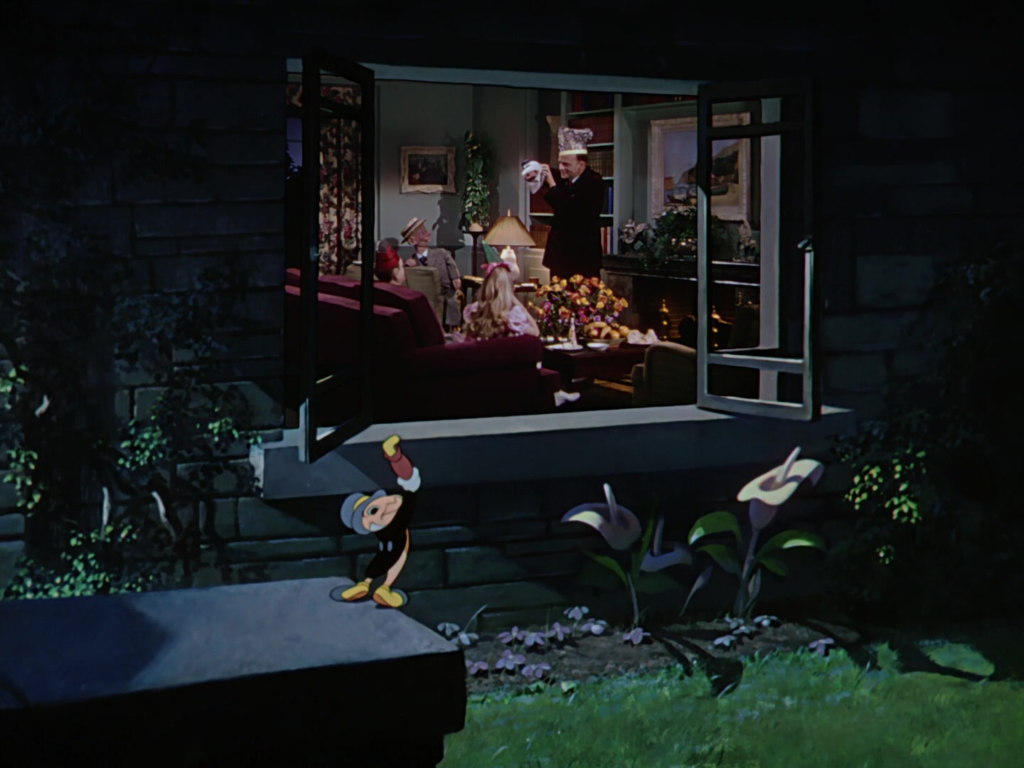
This opinion is not uncontroversial, but I love the use of Edgar Bergen and his characters in this movie! Mind you, it’s easy to see that Bergen’s lips are moving as his dummies’ speak, but their comedy really makes me laugh. I especially enjoy Charlie McCarthy’s un-Disney-esque cynicism and the way he constantly deflates Bergen’s overdramatic narration.
Bergen: All was misery, misery, misery!
Charlie: Just like the eighth grade.
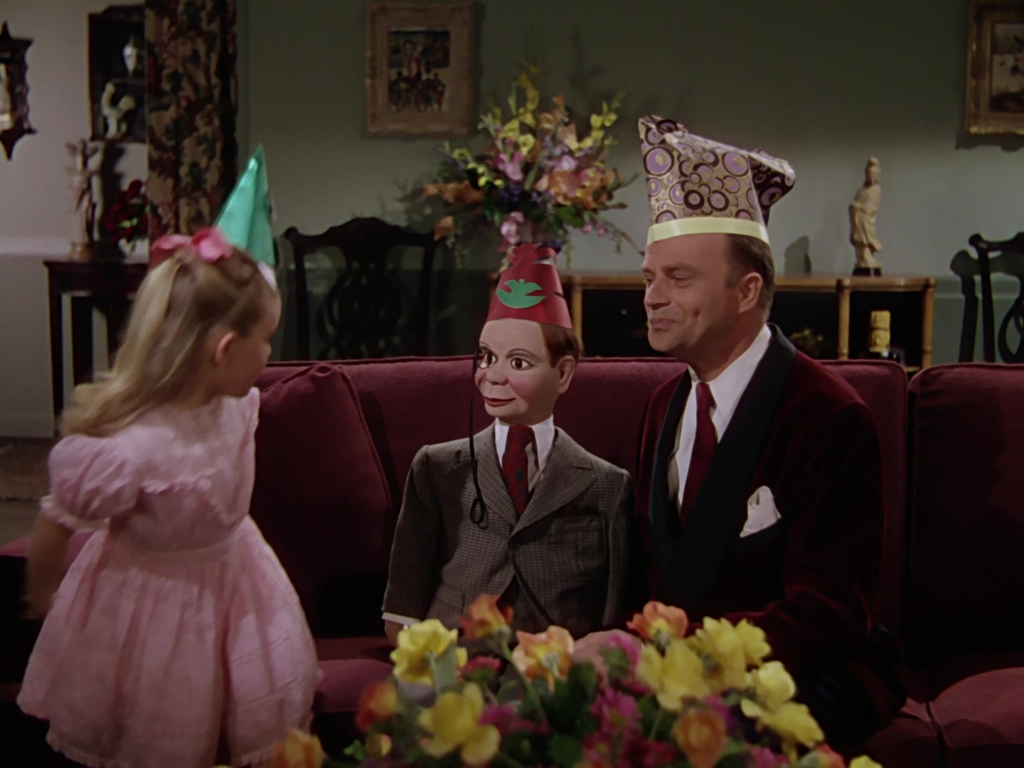
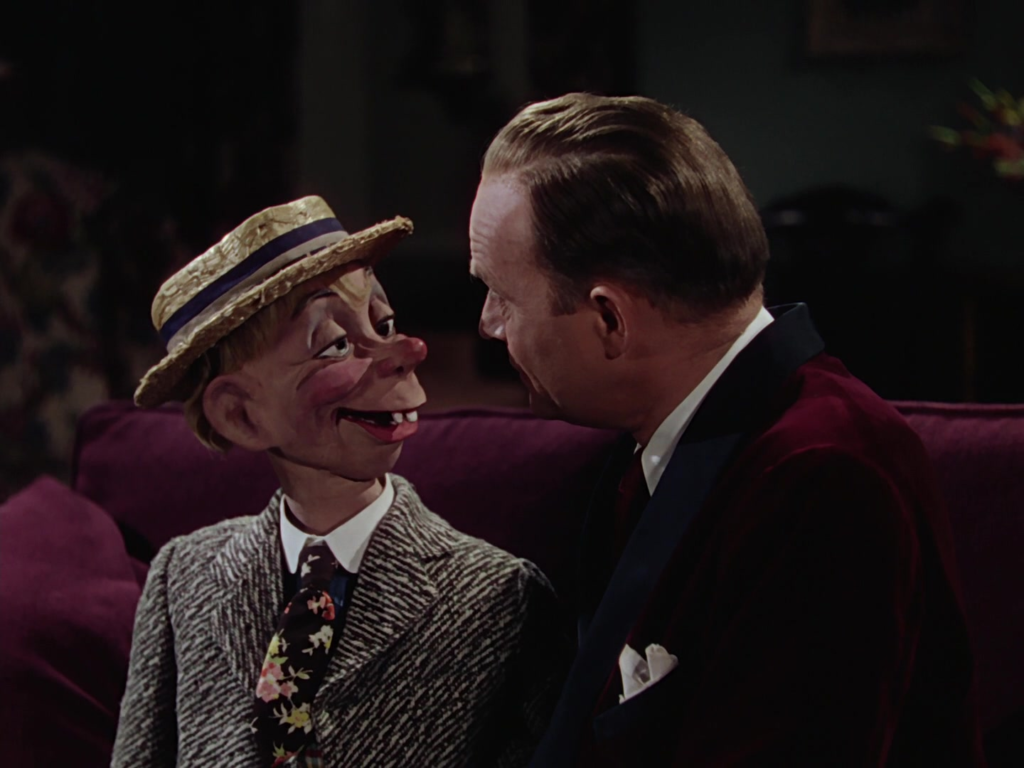
The cartoon itself, as you can guess from the title, is an adaptation of the famous English fairy tale, Jack and the Beanstalk with Mickey Mouse (voiced partly by Walt Disney and partly, for the first time, by James Macdonald) taking on the title role. Actually, he shares it with Donald Duck (Clarence Nash) and Goofy (Pinto Colvig)[5]It’s kind of refreshing to write about a cartoon featuring multiple voice actors. with Donald also fulfilling the role of Jack’s mother by throwing away the magic beans for which Mickey trades the trio’s cow. While I’m much more of a fan of the Looney Tunes characters than I am of Mickey, Donald and Goofy,[6]Actually, that’s not quite true. I’m mostly just a fan of Bugs Bunny and Daffy Duck. I don’t care much for Tweety or Sylvester or Wile E. Coyote or the Roadrunner. And it’s … Continue reading I will say that it’s impossible to give the main roles in a classic story to the Looney Tunes characters without either having it devolve into a simple chase scene/battle of wits or of being untrue to the spirit of Looney Tunes. Mickey and the Beanstalk, on the other hand, manages to be quite a decent retelling of its source material and a highly engaging cartoon comedy. As I mentioned, a lot of the humor comes from the narration but there are also some very funny visuals like the impossibly thin slices into which our impoverished heroes cut their last loaf of bread near the beginning.
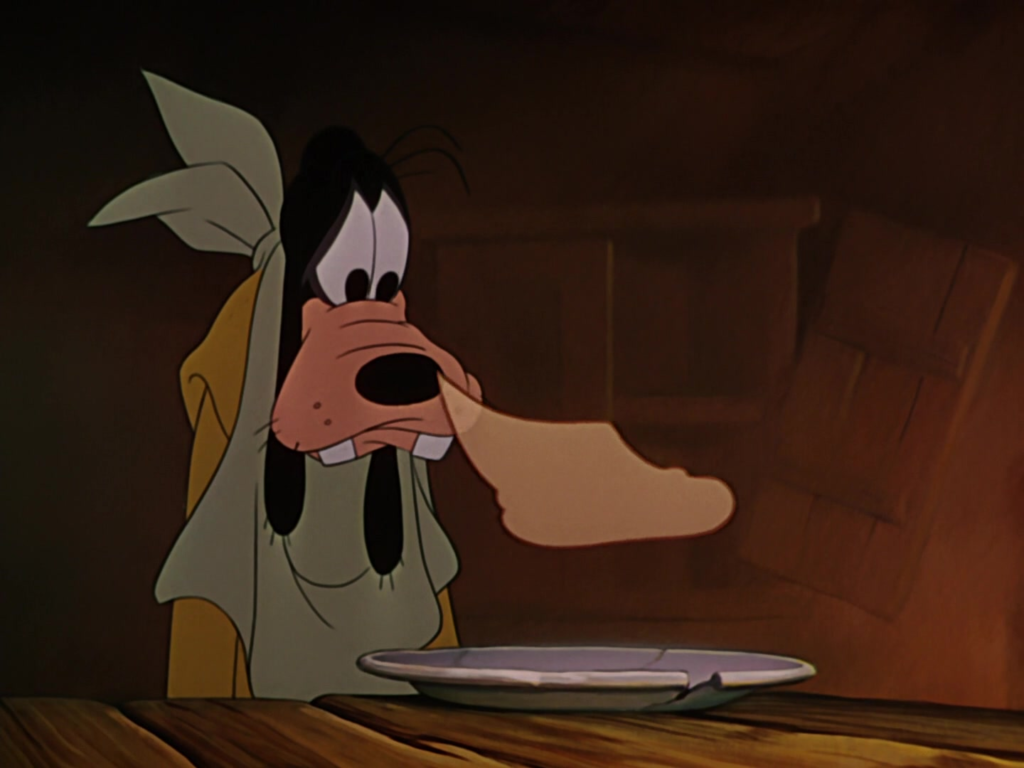
There’s also a fun and slightly eerie sequence of the giant beanstalk growing inside their house, breaking it apart and carrying it up, up into the sky while they obliviously sleep.
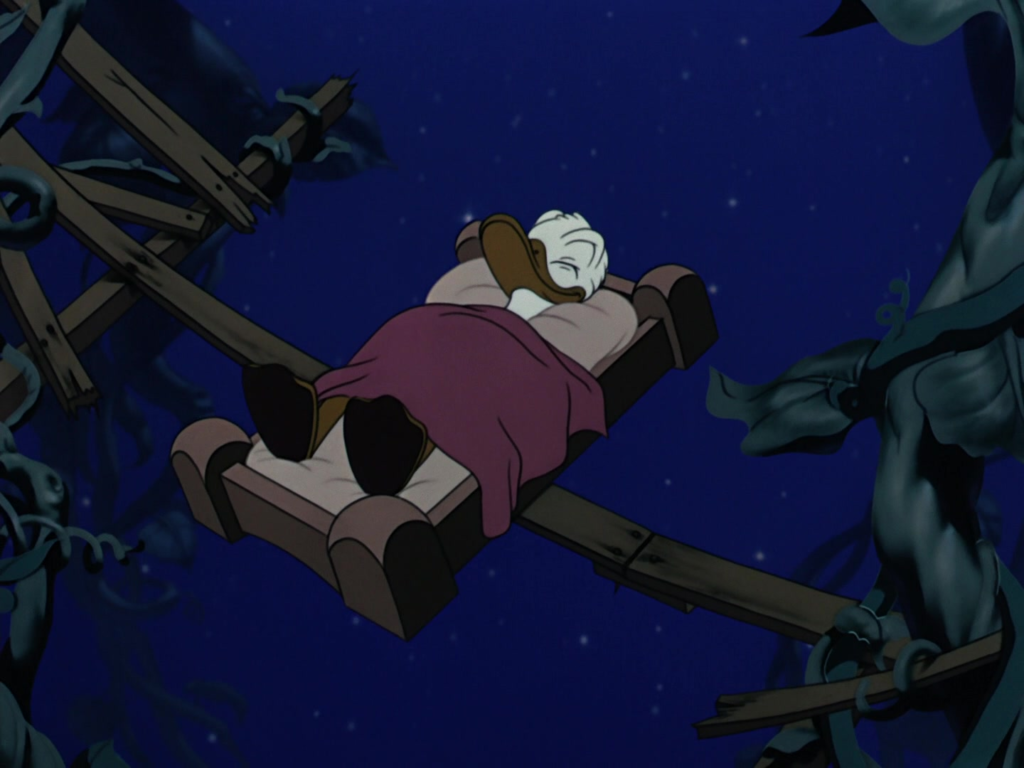
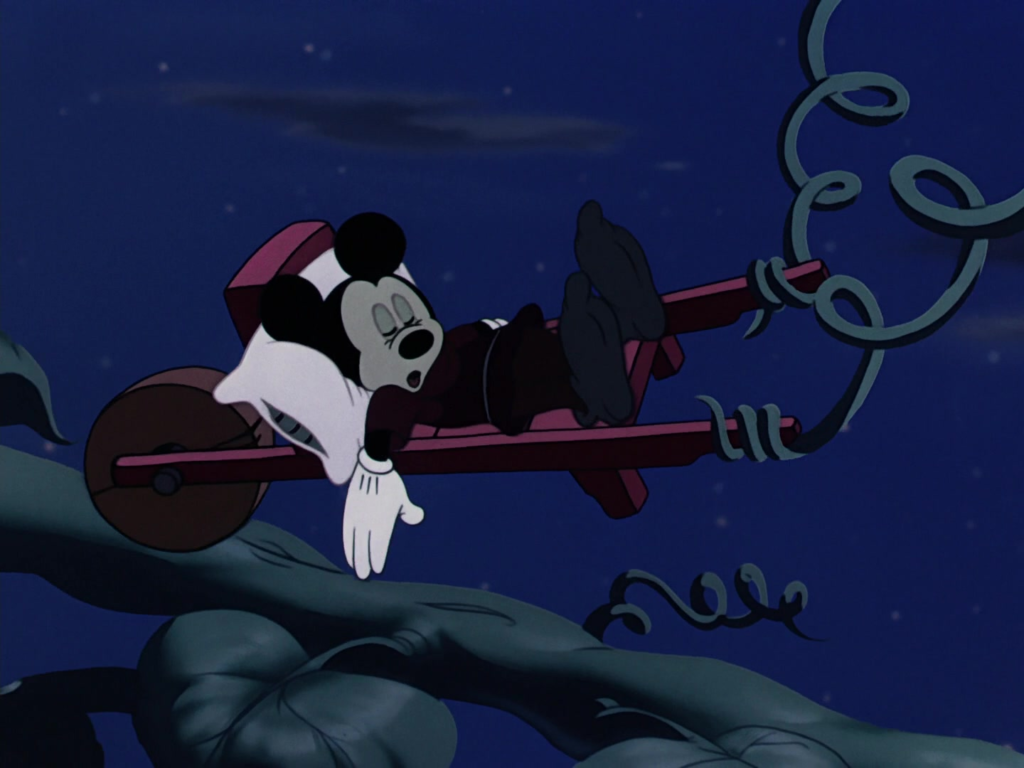
We also get a great comic villain in Willie the Giant (Billy Gilbert)[7]Whom Disney fans may remember also voiced Sneezy in Snow White and the Seven Dwarfs. who is entertainingly and even endearingly silly but also poses a palpable threat.

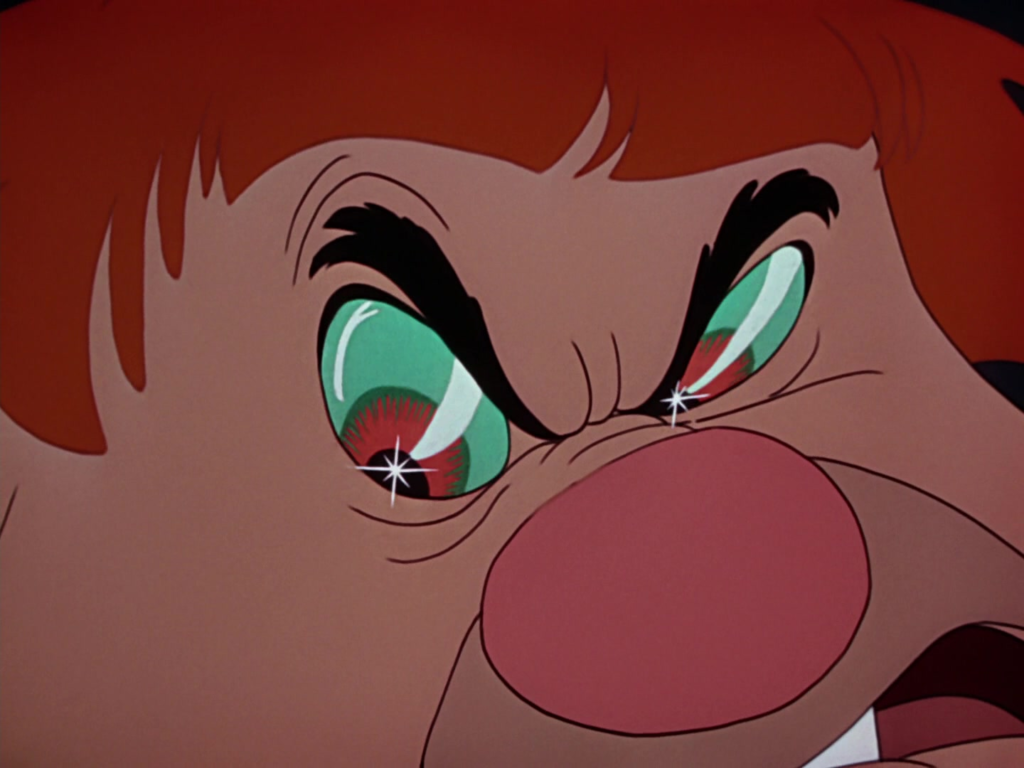
Like Bongo, Mickey and the Beanstalk has a very pleasant collection of songs. And it has an even better climax with Mickey having to steal a key from the sleeping giant’s pocket to free his imprisoned friends. Maybe somebody at the Disney company shared my love for that scene because not many years later their movie, Cinderella (1950), would have a very similar climax with mice characters to boot.
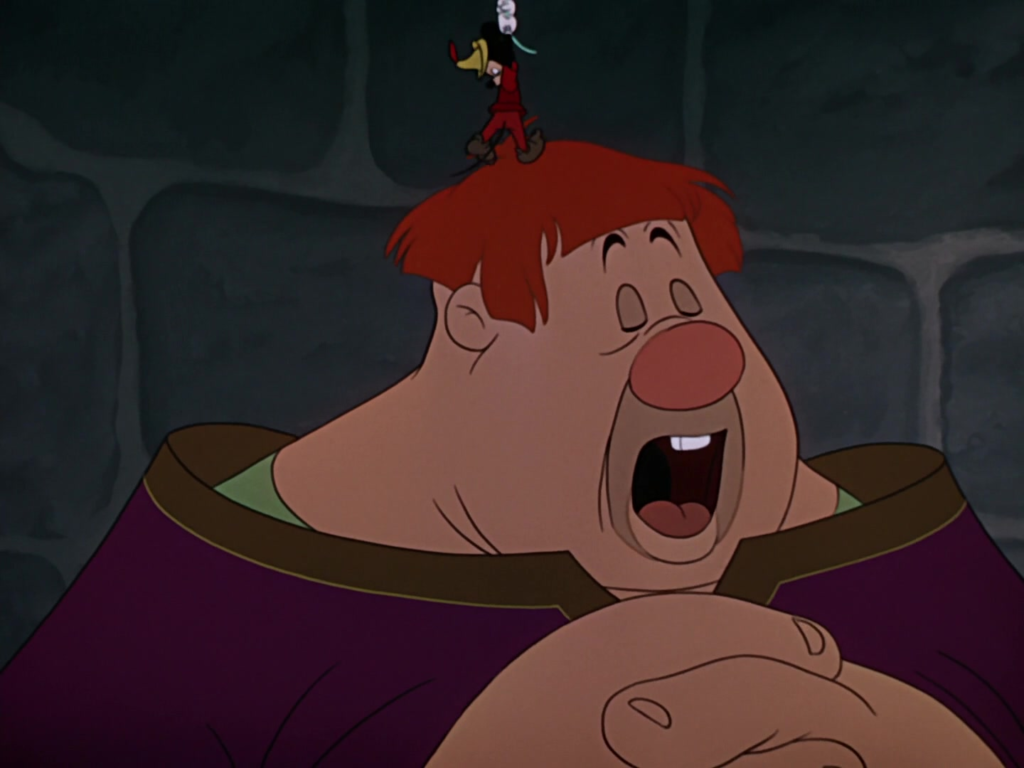
If I have any criticism of this featurette, it’s that it feels just a tad too short. (Maybe this reflects budget limitations.) While it spends a great deal of time establishing how bad the characters’ conditions have gotten at the beginning, we’re only told by Bergen that they improve after the giant’s defeat. We don’t actually get to see the happy ending. And it’s rather odd that we never learn who gave Mickey the magic beans. That seems like a rather crucial plot point not to explore. It’s pretty rare for any part of Disney’s anim-anthologies, even Fantasia, to leave me wanting more. I like it.
The Adventures of Ichabod and Mr. Toad (1949)
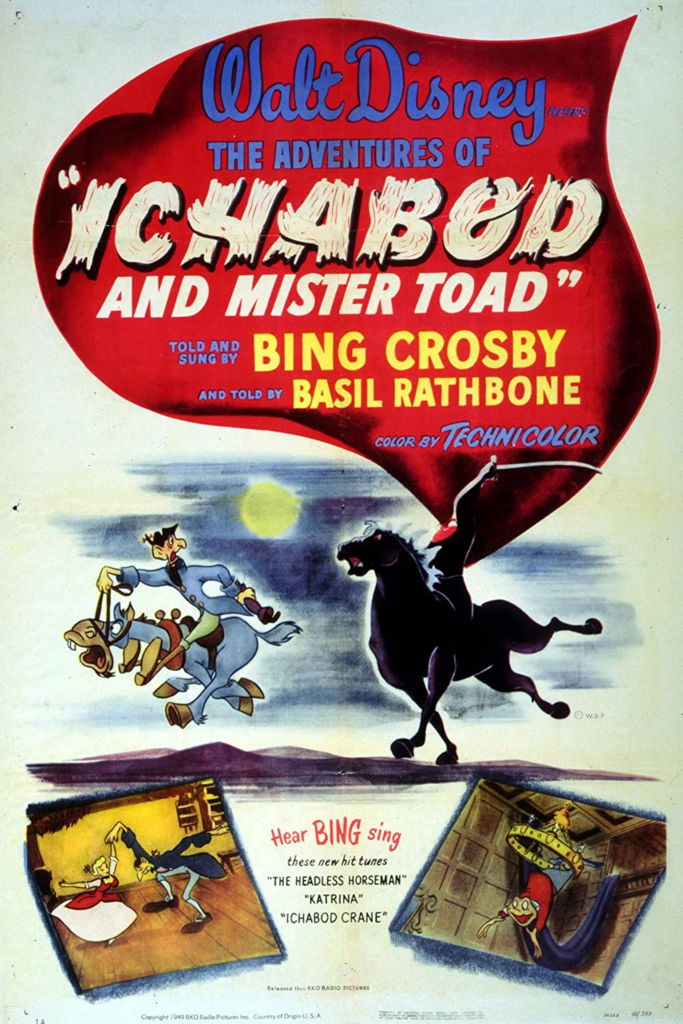
The Wind in the Willows
In contrast to the weirdly elaborate framing devices of Fun and Fancy Free, The Adventures of Ichabod and Mr. Toad has just one framing device and it’s the most bare-bones of any Disney anim-anthology other than that of Make Mine Music. We open in a library as an invisible narrator (Basil Rathbone) talks about fabulous English literary characters. His favorite, he claims, is J. Thaddeus Toad from The Wind in the Willows by Kenneth Grahame.[8]Actually, he’s only named J. Thaddeus in this adaptation, not the source material, but who’s keeping track? I am, that’s who. The book is pulled off the shelf and we segue into the first story.
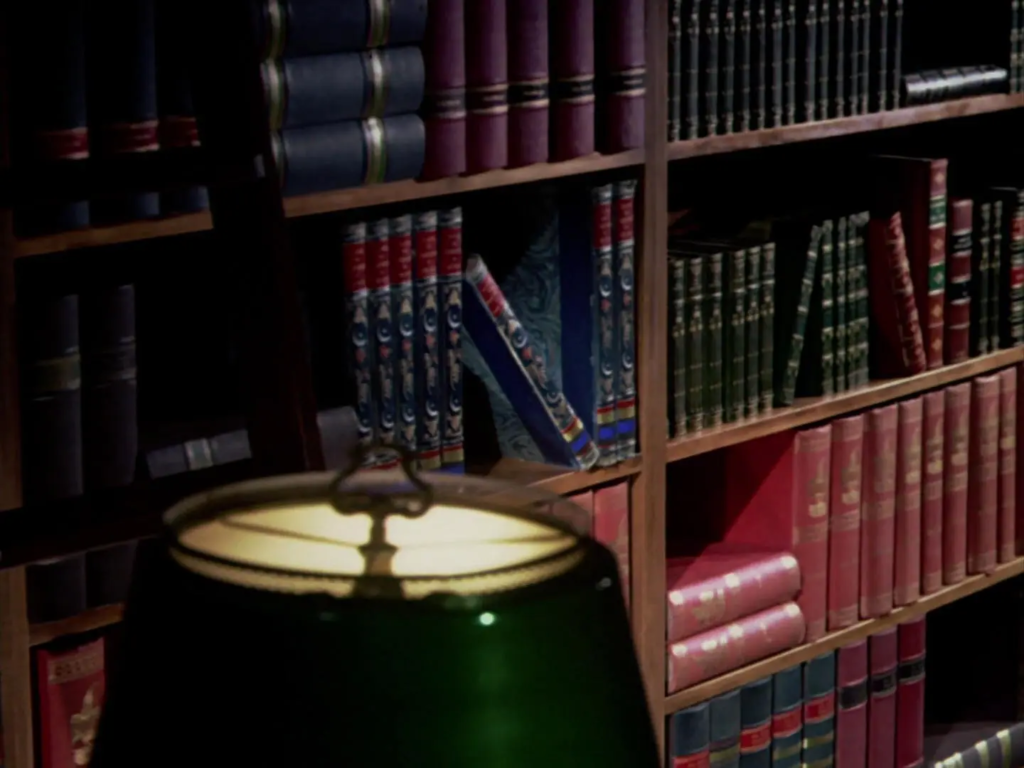
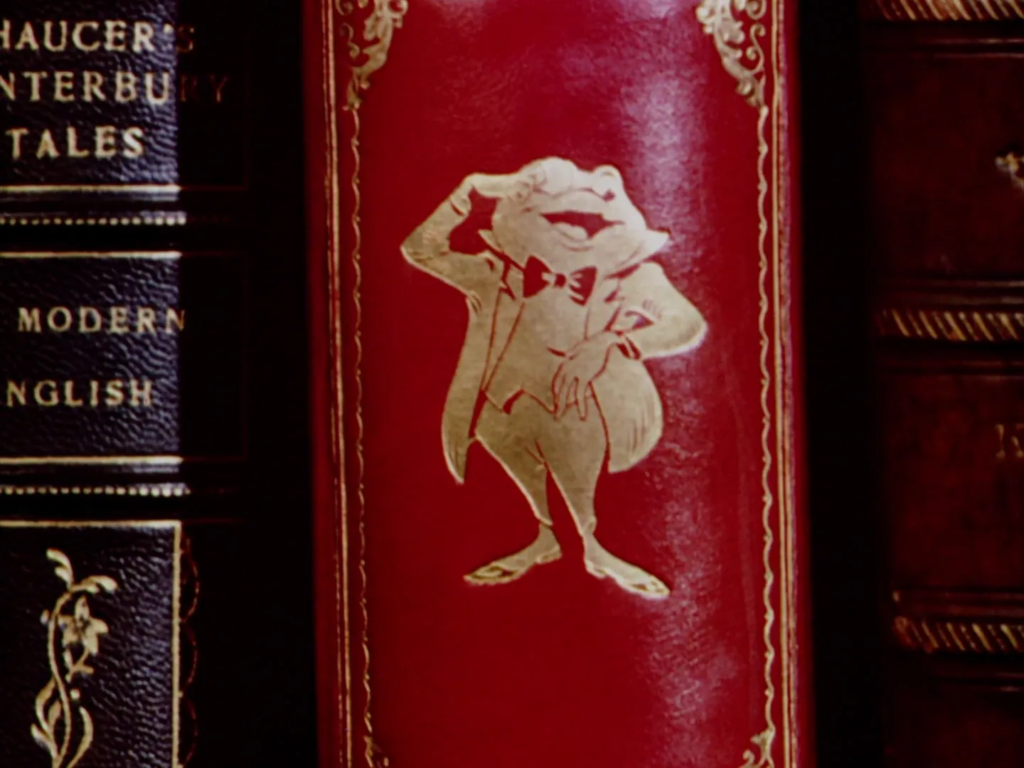
Toad (voiced by Eric Blore) is the richest animal along the riverbank and owns its most respectable estate, Toad Hall, but his weakness for the latest fads, mainly those involving modes of transportation, and his reckless driving skills are drowning him in debt. It’s gotten to the point that his friends, Rat (Claude Allister), Mole (Colin Campbell) and MacBadger (Campbell Grant) stage an intervention to keep him from buying a motor car. But Toad will not be stopped-at least not until his motor mania lands him in jail.
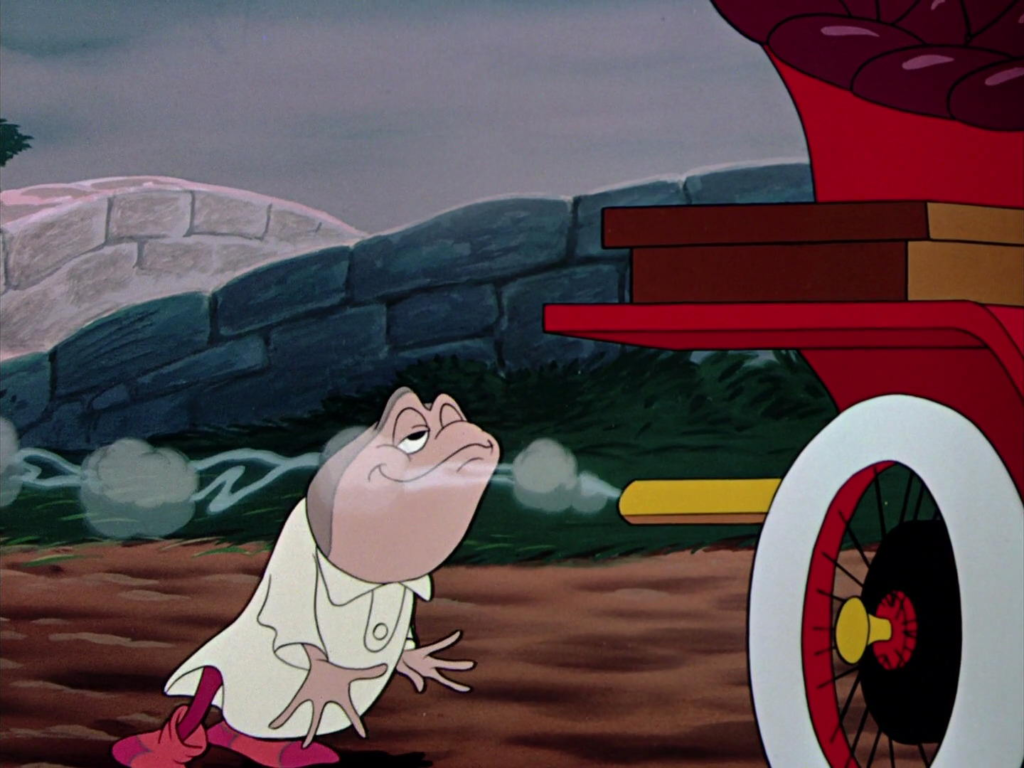
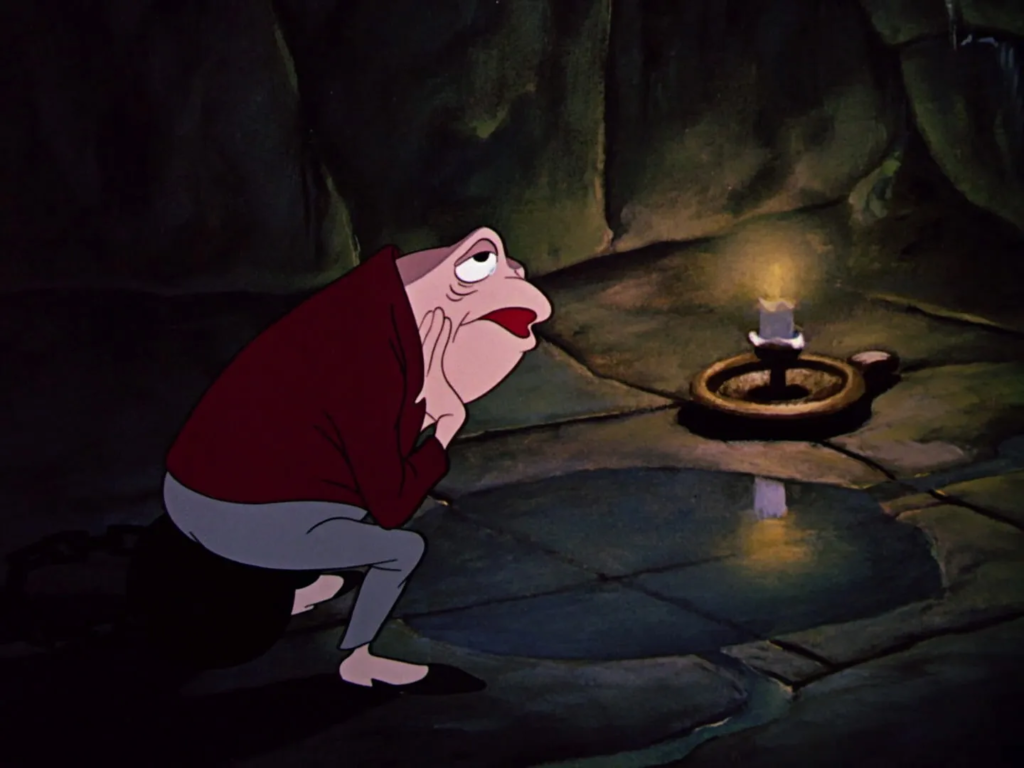
I’ve written about an animated adaptation of The Wind in the Willows before and if you go back and read that post, you can guess my criticisms of this one. As a fan, I’m displeased by how it simplifies and reimagines the characters, the better to make them comic foils for Toad. Rat, who, in the book, was very friendly and easygoing though he still had a temper, is here presented as a stereotypically uptight and stuffy Brit. Badger in the book was even more easygoing with his indifference toward table manners and grammar. He was also very physically intimidating, one of the few people who could pull Toad up short. Here he’s a weary, long-suffering codger, run ragged by the herculean task of managing Toad’s estate. Mole is actually reasonably close to his characterization in the book but with the focus solely on Toad, he naturally doesn’t get any of the original’s depth or nuance.
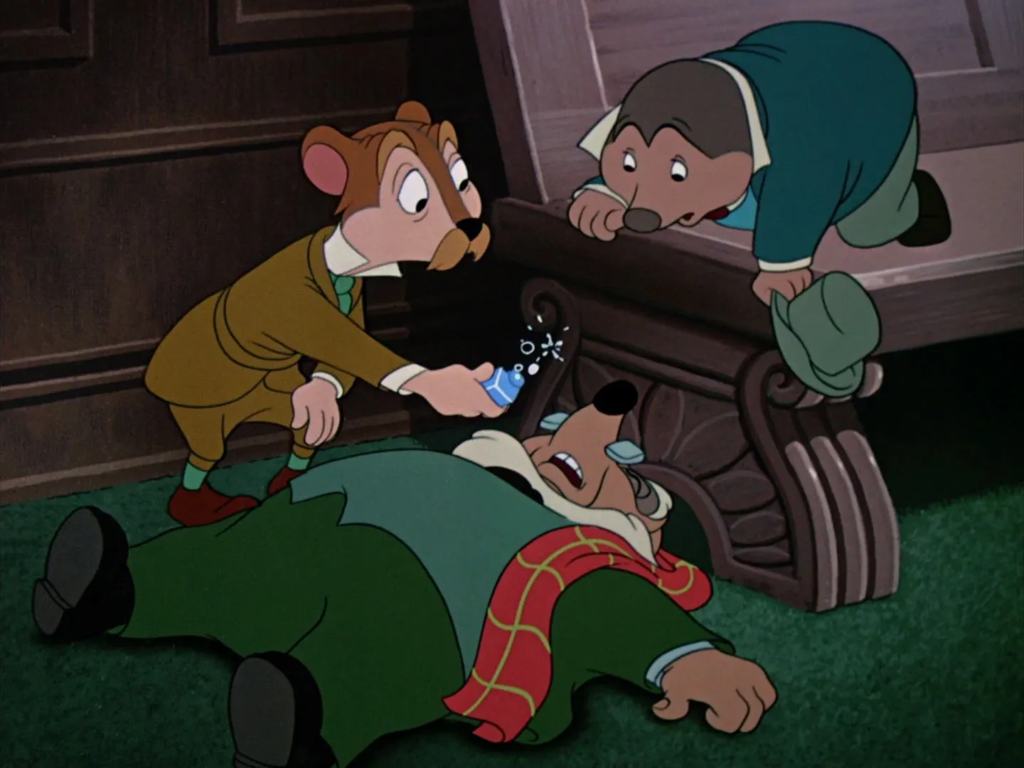
As you’d expect, this adaptation pretty much foregoes all of the poetic aspects of The Wind in the Willows and focuses entirely on comedy.[9]Which renders the title pretty inexplicable. Fortunately, they don’t mention it much. On its own terms though, this is something of a mini comic masterpiece. Toad is the character whose personality is closest to that of his literary counterpart, and he makes for a wonderful cartoon character with his indomitable energy and swagger. He’s beautifully animated and Blore’s vocal performance is perfect.
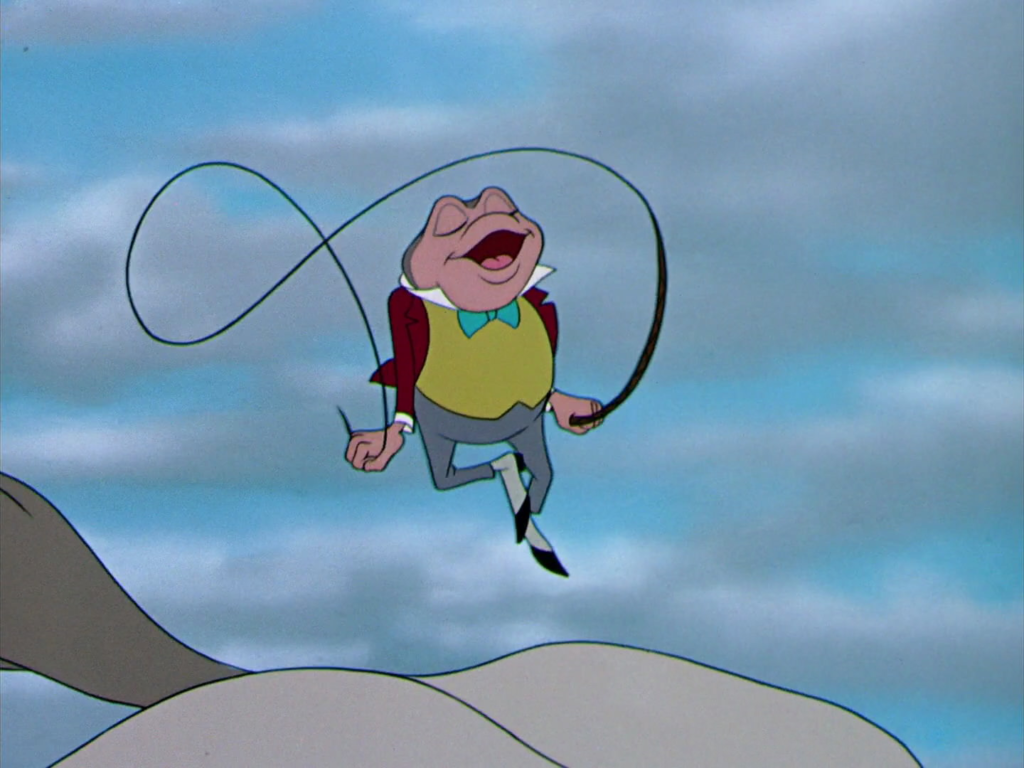
In fact, the character animation in this short in general is great. I love all the subtle yet hilarious touches like the way Mole keeps fumbling with his hat.
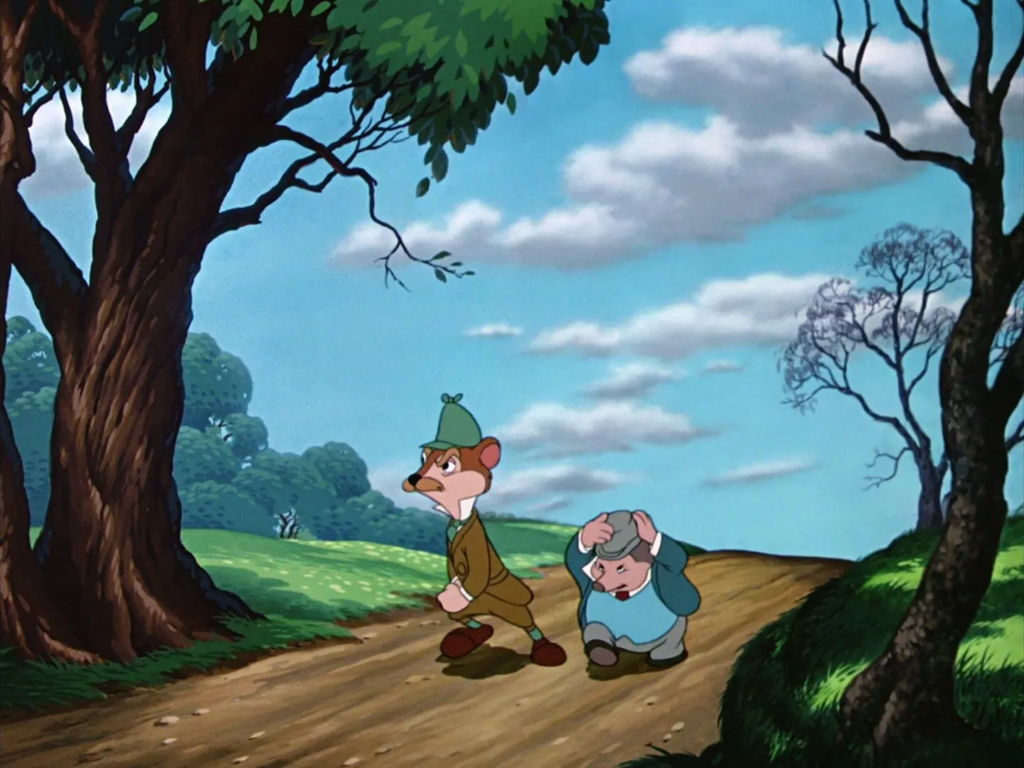
Skip this paragraph, if you don’t want to read any spoilers. The most notable change this Wind in the Willows makes to the original book’s plot, as opposed to its spirit, is that Toad is framed for stealing a car by the villainous weasels rather than actually taking one for a joyride. Instead of climaxing with the heroes driving the weasels out of Toad Hall by force, they have to steal the deed to Toad Hall from them to prove that Toad gave it to them in the exchange for the hot vehicle.[10]The book just sort of weirdly assume that once Toad reaches home after escaping from prison, he won’t be rearrested. This doesn’t really make a lot of sense. It seems like all the characters would have to do is send the police over to Toad Hall to ask the weasels what they’re doing there. If they responded by showing them the deed, that would prove Toad was telling the truth and if they burned the deed, then the police could evict them, which, to be fair, would mean Toad could never be exonerated and that’s not what the heroes want. Maybe it’s the weasels’ plotting that I should be criticizing. But, anyway, if you ignore the lapses in logic, I have to admit this reimagined climax is far more fun and interesting than a simple fight like the book’s climax would have been.[11]Someone at Disney must have agreed with me because the 1967 Jungle Book would reuse part of its choreography, though with switching the good guys and bad guys oddly.
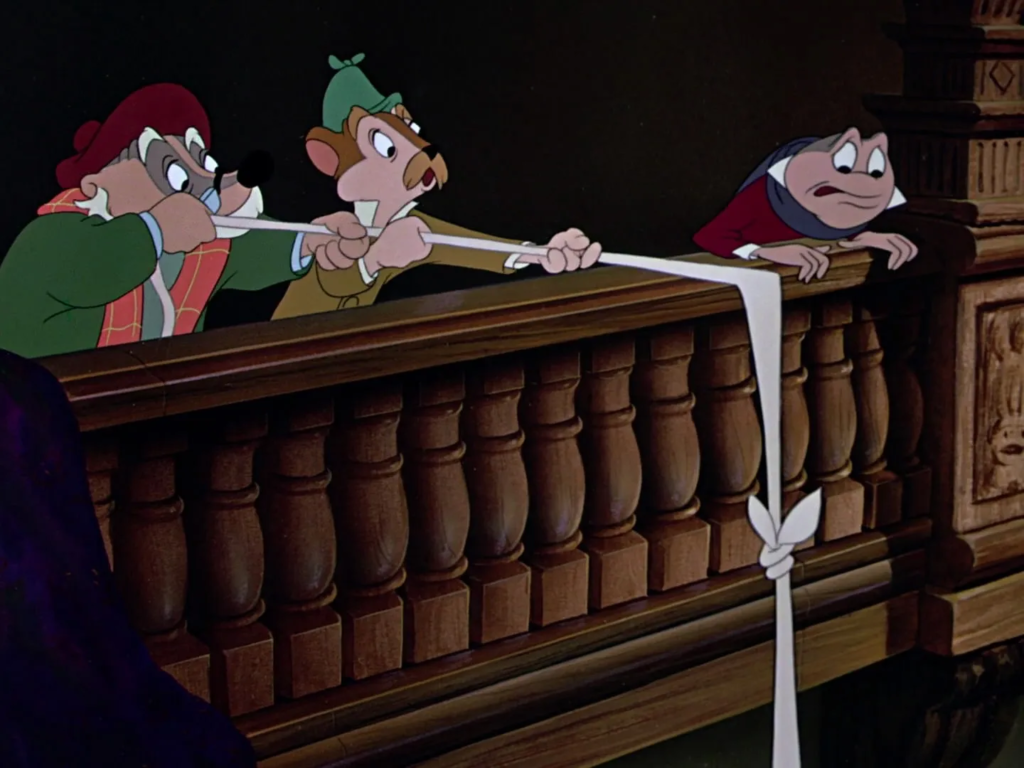
The Legend of Sleepy Hollow
Back in the library, Bing Crosby takes over voiceover narration and turns the subject to fabulous American literary characters. The one he picks as the best is Ichabod Crane, the superstitious schoolmaster from Washington Irving’s The Legend of Sleepy Hollow. That wouldn’t have been my choice, but oh well, it’s probably better than some of the other candidates he mentions like Pecos Bill and Paul Bunyan.
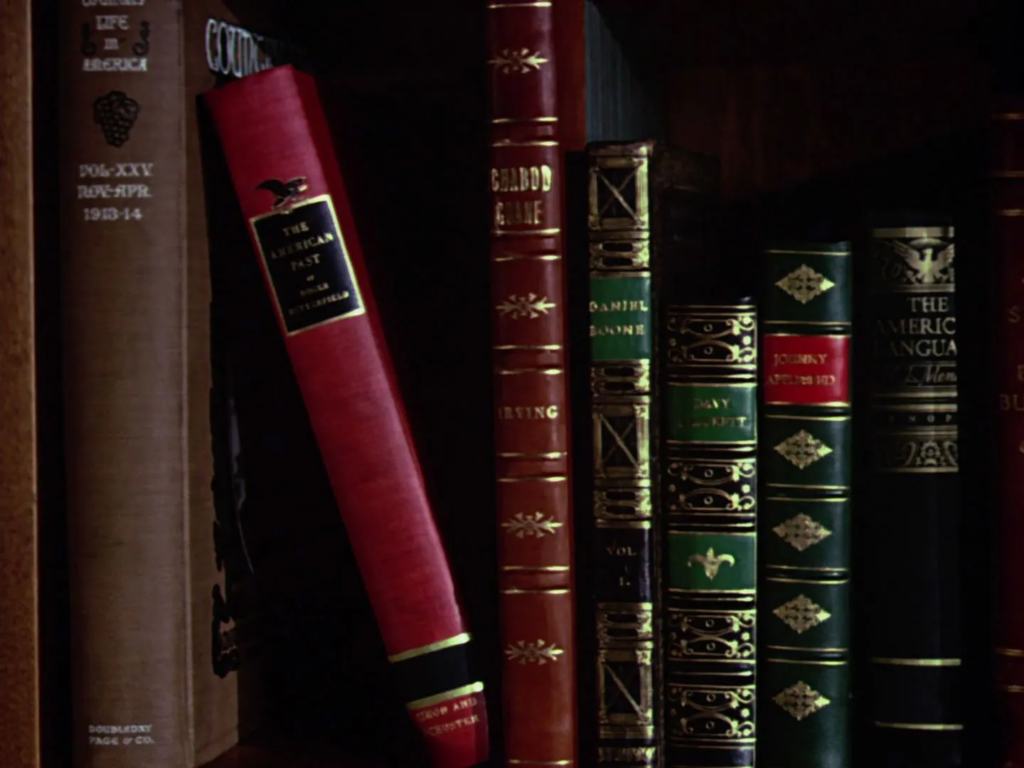
This is my favorite of the movie’s two halves, mostly because I’m not attached to the source material. As much as I appreciate Washington Irving’s prose, his stories don’t do much for me. If anything, I’d say this adaptation improves the story by playing it more broadly for laughs. You see, none of the characters are particularly likeable. Ichabod is a vain gluttonous gold digger, and he ends up coming across as a sympathetic underdog by default. His romantic rival, Brom Bones, is a violent boor who scares away any man that might get between him and his girl. And the lynchpin of this love triangle, Katrina Von Tassel, is implied to be a heartless flirt who leads Ichabod on to tease Brom. What makes this work is how humorously it plays out as well as the short running time which doesn’t demand any particular investment from the viewer. Ichabod is a brilliant piece of comic character design with his spindly limbs and weirdly shaped head, and the middle section of the cartoon, with Brom increasingly desperate to pummel him and Ichabod evading all his attempts through cleverness, Katrina’s intervention or sheer luck, is hilarious.
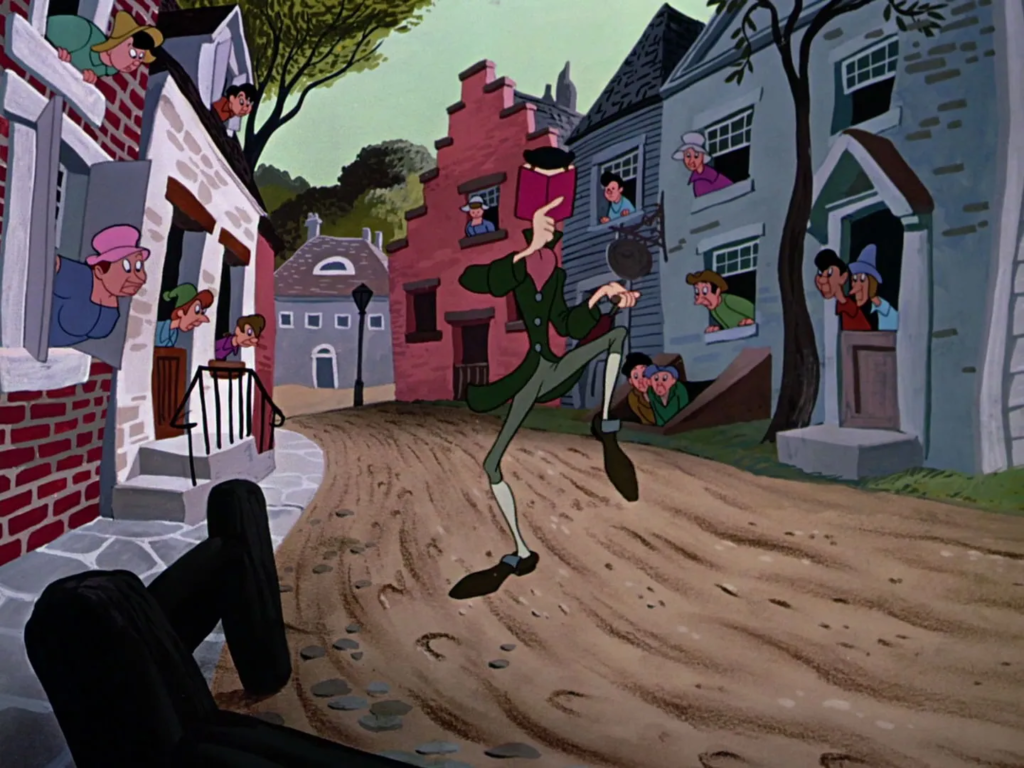


The backgrounds in The Legend of Sleepy Hollow are prettier than those in The Wind in the Willows and that’s no faint praise.
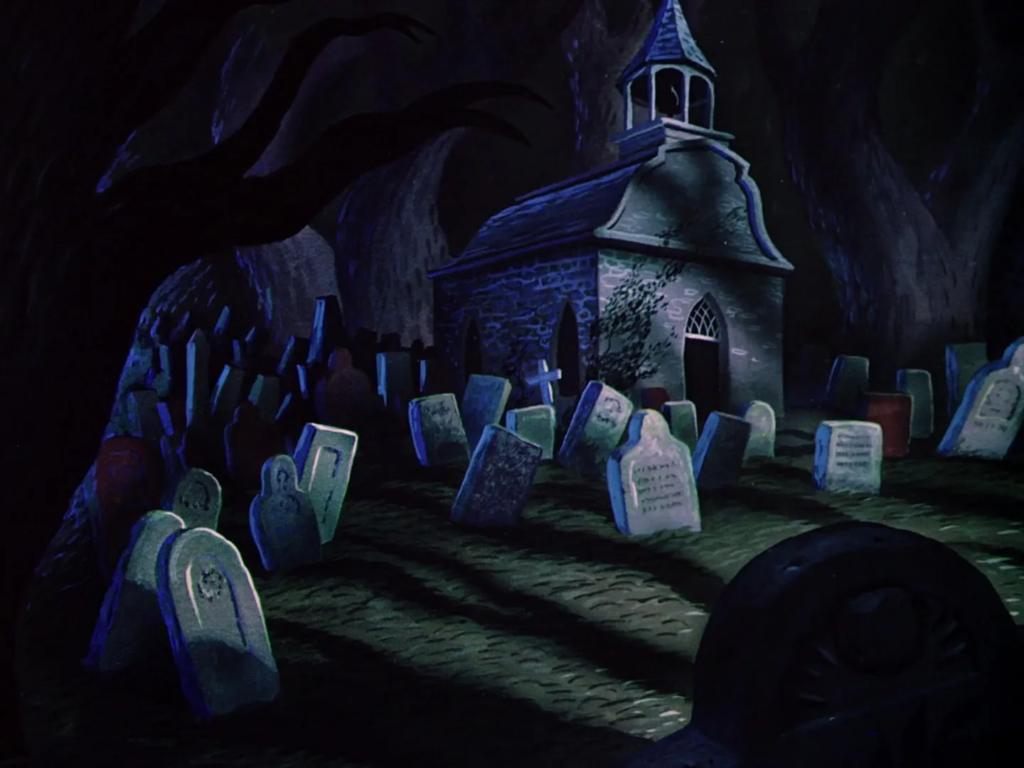
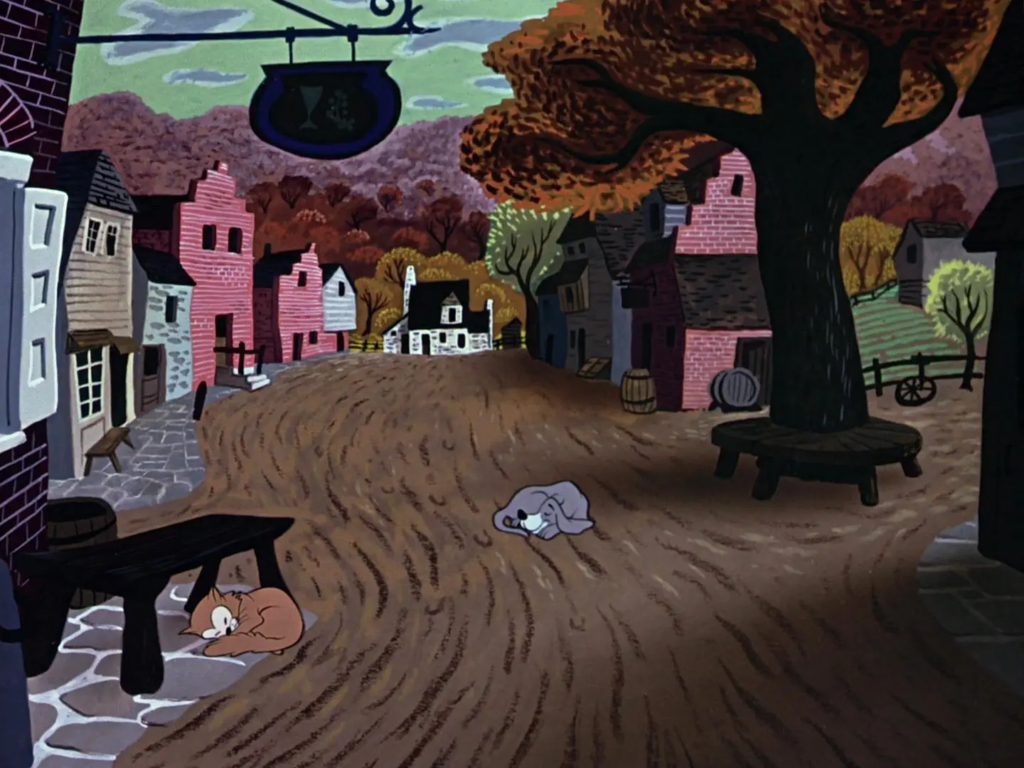
This is another short where a single person does all the voices-well, a single person and a backup chorus. Bing Crosby and The Rhythmaires are more than up to the task. The three songs by Don Raye and Gene de Paul[12]The credits specifically credit them for the Ichabod half of the movie. are all hidden gems. The catchiest and most fun is definitely The Headless Horseman which Brom sings at Katrina’s Halloween party.
This, of course, leads to the scene of Ichabod riding home alone through the haunted wood and being pursued by the phantom, which is one of the most masterly scenes in any Disney anim-anthology. The buildup, the reveal, the chase…If you want to watch something that’s terrifying, really funny and rated G, this film perfectly fits that specific and somewhat contradictory bill.


More spoilers in this paragraph. Reading the original Legend of Sleepy Hollow, it’s hard not to conclude that the headless horseman was really Brom in some sort of Scooby Doo-style disguise and that he either murdered Ichabod or scared him out of the community for good. At first, it seems like this version is going to lean harder into that as Brom is the one who initiates the talk about the horseman and does so with a rather malicious and crafty expression on his face. (In Irving, Brom’s ghost story is just one of many and is even one of the less scary ones.) But we get such a close look at Ichabod’s pursuer that this seems doubtful. At one point, Ichabod even peers down his neck hole. On the other hand, if the horseman is really what he seems, what was Brom up to earlier? Was he just trying to give his rival a heart attack? Are he and the ghost in cahoots somehow? Did he use black magic? The story doesn’t really make sense if you think about it, but, for me anyway, it’s easy to not think about it and, like Toad but unlike Ichabod, enjoy the ride.

Conclusion
The Adventures of Ichabod and Mr. Toad is generally considered superior to Fun and Fancy Free. I can’t build a super strong case against that, mainly since it’s the more consistently great of the two. It’s mostly the second half of Fun and Fancy Free that I love. But maybe because I’m fonder of that second half than I am of either half of Ichabod and Mr. Toad, I prefer the earlier movie. I’ll grant you that it’s the more random of the two. Even the title, Fun and Fancy Free, is kind of arbitrary. (While both segments are lighthearted on the whole, the characters in them do face grim challenges at certain points.) But its randomness feels like it’s by design almost and, for me, is part of its appeal. The slightly less random quality of Ichabod and Mr. Toad, on the other hand, makes its randomness stand out more. Why just two stories about larger-than-life literary characters, an English one and an American one? Why not throw in a French one or something?[13]You could argue another thematic connection is that both Toad and Ichabod are ruled by their instincts and appetites, which gets them into trouble. I suppose that would either make the movie too long or require cutting from both halves, a sad prospect. To me, there’s something appealing and relaxing about the laidback atmosphere of all Disney’s anim-anthology movies.[14]Part of their appeal for me may also be that books, not movies, are my true love and there are plenty of books that are anthologies of short stories. The idea of a movie being like that doesn’t … Continue reading While they have plenty of excitement within the individual shorts, there’s no overarching question hanging over any of them besides, “what comes next?” In the words of a song from The Adventures of Ichabod and Mr. Toad, the one song from the Wind in the Willows part, they’re “merrily, merrily, merrily, merrily on their way/ to nowhere in particular.” And Fun and Fancy Free might just be the most laidback and appealingly random of them all.
Still, Ichabod and Mr. Toad did end the trend of Disney anim-anthologies on a high note-though it didn’t end them forever…
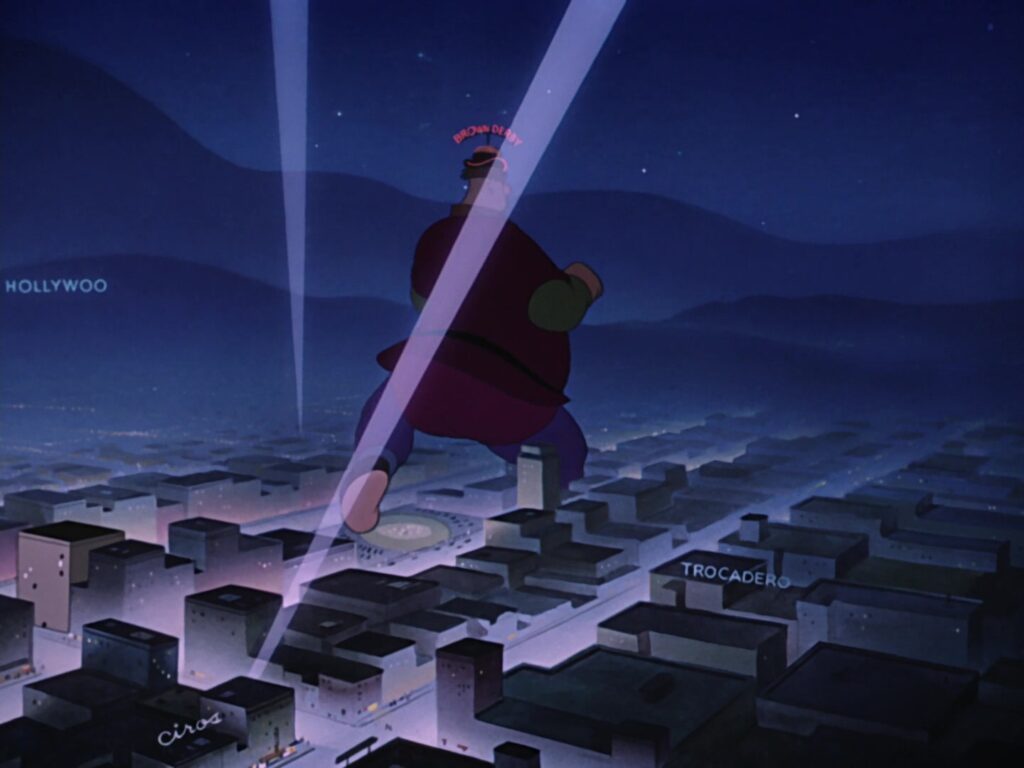
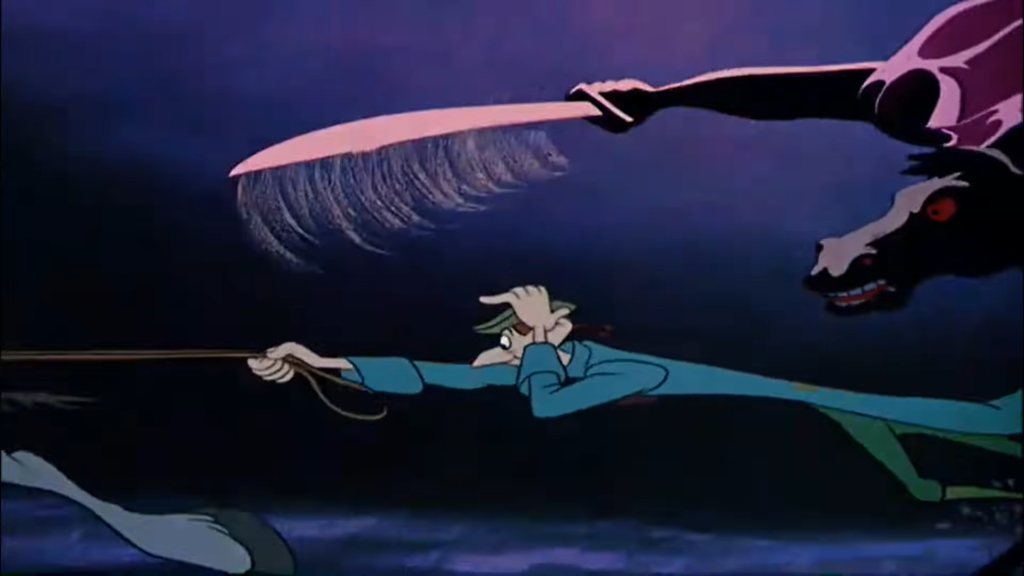
To Be Continued
References
| ↑1 | I haven’t been mentioning who wrote all the songs for the Disney anim-anthologies except for Fantasia‘s classical compositions. That’s partly because there were so many of them by so many different people, that it’s hard to keep track. |
|---|---|
| ↑2 | I wonder if the fact that Jiminy doesn’t choose one of the records labeled Bach or Beethoven in the background can be seen as a renunciation of Fantasia. |
| ↑3 | I’d call this a Disney-fied Call of the Wild, but there actually was a Disney version of Call of the Wild in 2020. |
| ↑4 | At one point in its production history, when it was going to be a feature length movie, Mickey and the Beanstalk was apparently going to have a very different framing device, one that sounds more like something Warner Bros or Dreamworks would do. (In fact, Warner Bros actually did do it with the 1950 Daffy Duck cartoon, The Scarlet Pumpernickel.) Mickey Mouse, Donald Duck and Goofy would be going on strike, demanding that Disney give them roles in a feature film. Mickey and the Beanstalk would be their pitch. At the end, the producers would reject the proposal, saying that the lack of princesses and cute animals made it unmarketable. |
| ↑5 | It’s kind of refreshing to write about a cartoon featuring multiple voice actors. |
| ↑6 | Actually, that’s not quite true. I’m mostly just a fan of Bugs Bunny and Daffy Duck. I don’t care much for Tweety or Sylvester or Wile E. Coyote or the Roadrunner. And it’s mostly the Chuck Jones and Friz Freleng versions of Bugs and Daffy that I love. I don’t care much for the older takes on them. |
| ↑7 | Whom Disney fans may remember also voiced Sneezy in Snow White and the Seven Dwarfs. |
| ↑8 | Actually, he’s only named J. Thaddeus in this adaptation, not the source material, but who’s keeping track? I am, that’s who. |
| ↑9 | Which renders the title pretty inexplicable. Fortunately, they don’t mention it much. |
| ↑10 | The book just sort of weirdly assume that once Toad reaches home after escaping from prison, he won’t be rearrested. |
| ↑11 | Someone at Disney must have agreed with me because the 1967 Jungle Book would reuse part of its choreography, though with switching the good guys and bad guys oddly. |
| ↑12 | The credits specifically credit them for the Ichabod half of the movie. |
| ↑13 | You could argue another thematic connection is that both Toad and Ichabod are ruled by their instincts and appetites, which gets them into trouble. |
| ↑14 | Part of their appeal for me may also be that books, not movies, are my true love and there are plenty of books that are anthologies of short stories. The idea of a movie being like that doesn’t bother me the way it does some people. |
